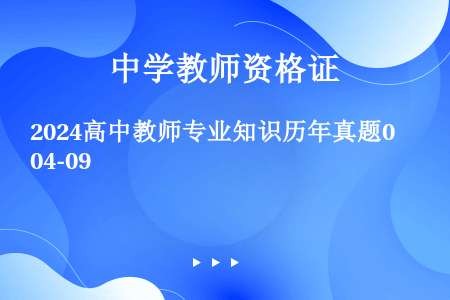教师公考类 | 中学教师资格证
历年真题
2024高中教师专业知识历年真题04-09

1、 下列选项中,不属于美术质性评价的是( )(易混) (单选题)
A. 展示
B. 评语
C. 等级
D.
档案袋
试题答案:C
2、
请阅读Passage l,完成{TSE}小题。
Passage 1
In the field of psychology, there has long been a certain haziness surrounding the definition of creativity, an I-know-it-when-I-see-it attitude that has eluded a precise formulation. During our conversation, Mark Beeman, a cognitive neuroscientist at Northwestern University, told me that he used to be reluctant to tell people what his area of study was, for fear of being dismissed or misunderstood. What, for instance, crosses your mind when you think of creativity? Well, we know that someone is creative if he produces new things or has new ideas. And yet, as John Kounios, a psychologist at Drexel University who collaborates frequently with Beeman, points out, that view is wrong, or at least not entirely right. "Creativity is the process, not the product," he says.
To illustrate, Beeman offers an example. Imagine someone who has never used or seen a paperclip and is struggling to keep a bunch of papers together. Then the person comes up with a new way of bending a stiff wire to hold the papers in place. "That was very creative," Beeman says. On the flip side, if someone works in a new field--Beeman gives the example of nanotechnology--anything that he produces may be considered inherently "creative." But was the act of producing it actually creative? As Beeman put it,"Not all artists are creative. And some accountants are very creative."
Insight, however, has proved less difficult to define and to study. Because it arrives at a specific moment in time, you can isolate it, examine it, and analyze its characteristics. "Insight is only one part of creativity," Beeman says."But we can measure it. We have a temporal marker that something just happened in the brain. I´d never say that´s all of creativity, but it´s a central,identifiable component." When scientists examine insight in the lab, they are looking at what types of attention and thought processes lead to that moment of synthesis: If you are trying to facilitate a breakthrough, are there methods you can use that help? If you feel stuck on a problem, are there tricks to get you through?
In a recent study, Beeman and Kounios followed people´s gazes as they attempted to solve what´s called the remote-associates test, in which the subject is given a series of words, like "pine,""crab," and "sauce," and has to think of a single word that can logically be paired with all of them.
They wanted to see if the direction of a person´ s eyes and her rate of blinking could shed light on her approach and on her likelihood of success. It turned out that if the subject looked directly at a word and focused on it--that is, blinked less frequently, signaling a higher degree of close attention--she was more likely to be thinking in an analytical, convergent fashion, going through possibilities that made sense and systematically discarding those that didn´ t. If she looked at "pine,"say, she might be thinking of words like "tree," "cone," and "needle," then testing each option to see if it fit with the other words. When the subject stopped looking at any specific word, either by moving her eyes or by blinking, she was more likely to think of broader, more abstract associations.
That is a more insight-oriented approach."You need to learn not just to stare but to look outside your focus," Beeman says. (The solution to this remote-associates test: "apple. ")
As it turns out, by simple following someone´s eyes and measuring her blinks and fixation times, Beeman´s group can predict how someone will likely solve a problem and when she is nearing that solution. That´s an important consideration for would-be creative minds: it helps us understand how distinct patterns of attention may contribute to certain kinds of insights.
{TS}Which of the following is closest in meaning to the underlined word"haziness" in PARAGRAPH ONE?
(单选题)
A. Arbitrariness.
B. Vagueness.
C. Misunderstanding.
D. Controversy.
试题答案:B
3、
10.此题暂缺
(单选题)
试题答案:暂无答案
4、 为帮助高中学生掌握美术鉴赏方法,美术教师需要做到的是( )。 (单选题)
A. 讲解艺术家的轶闻趣事,提高学生学习兴趣
B. 介绍作品的艺术价值或拍卖的价格,引起学生的震动
C. 讲述作品中的故事和情节.让学生理解主题和内容
D. 指导学生学会描述、分析、解释、评价美术作品
试题答案:D
5、
下面谱例出自维瓦尔第《四季》的哪一部分?( )
 (单选题)
(单选题)
A. 《春》
B. 《夏》
C. 《秋》
D. 《冬》
试题答案:D
-
2024高中教师专业知识历年真题04-18
2024-04-18 -
2024高中教师专业知识历年真题04-17
2024-04-17 -
2024高中教师专业知识历年真题04-16
2024-04-16 -
2024高中教师专业知识历年真题04-15
2024-04-15 -
2024高中教师专业知识历年真题04-14
2024-04-14 -
2024高中教师专业知识历年真题04-13
2024-04-13 -
2024高中教师专业知识历年真题04-12
2024-04-12 -
2024高中教师专业知识历年真题04-11
2024-04-11 -
2024高中教师专业知识历年真题04-10
2024-04-10 -
2024高中教师专业知识历年真题04-09
2024-04-09

扫码关注不迷路
-
 题王微信公众号
题王微信公众号微信搜“题王网”真题密题、最新资讯、考试攻略、轻松拿下考试
推荐考试
Copyright © 2020-2020 深圳市题王科技有限公司 All Right Reserved.


